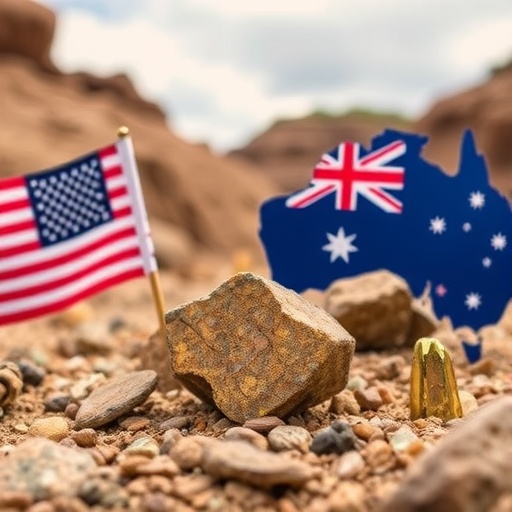U.S. and Australia Seal $8 Billion Critical Minerals Agreement to Counter Global Supply Risks
In a bold move to reshape global supply chains, the United States and Australia have inked a landmark $8 billion agreement focused on critical minerals, aiming to reduce dependency on volatile international sources and fortify economic ties. Announced during high-level talks in Washington, D.C., the pact targets essential resources like lithium, cobalt, and rare earth elements, which power everything from electric vehicles to renewable energy technologies. This trade agreement not only promises to inject billions into joint mining and processing ventures but also underscores a deepening strategic partnership amid escalating geopolitical tensions.
The deal, signed by U.S. Secretary of Commerce Gina Raimondo and Australian Minister for Resources Madeleine King, comes at a pivotal moment. With China controlling over 80% of the world’s rare earth processing and recent export restrictions rattling markets, the U.S. and Australia are positioning themselves as reliable alternatives. “This agreement is a game-changer for securing our future in clean energy and defense technologies,” Raimondo stated in a press briefing. The initiative is expected to create thousands of jobs and accelerate the transition to sustainable energy, addressing vulnerabilities exposed by supply disruptions during the COVID-19 pandemic and ongoing U.S.-China trade frictions.
Breaking Down the Core Elements of the Critical Minerals Pact
At the heart of this agreement lies a comprehensive framework designed to streamline critical minerals extraction, refining, and trade between the U.S. and Australia. Valued at up to $8 billion over the next decade, the pact allocates funds for co-investment in mining projects, technology transfers, and infrastructure development. For instance, Australian firms like Rio Tinto and BHP will partner with U.S. companies such as Tesla and General Motors to expand lithium production in Western Australia’s Pilbara region, a hotspot for high-grade deposits.
Key provisions include streamlined permitting processes to expedite project approvals, reducing bureaucratic hurdles that have historically delayed critical minerals developments. The agreement also establishes a bilateral working group to monitor supply chain risks and coordinate responses to market fluctuations. According to a joint statement, investments will prioritize environmentally sustainable practices, incorporating advanced recycling technologies to minimize ecological impacts. Statistics from the U.S. Geological Survey highlight the urgency: the U.S. currently imports 100% of its cobalt and 76% of its lithium, making domestic and allied sourcing imperative.
Under the deal, Australia commits to increasing its critical minerals exports to the U.S. by 50% within five years, while the U.S. pledges tax incentives for companies investing in Australian operations. This reciprocal approach is poised to transform raw material flows, with projections estimating an additional $2 billion in annual trade volume by 2030. Experts note that such measures could lower costs for battery manufacturers, potentially reducing electric vehicle prices by 10-15% in the coming years.
Geopolitical Chess: Shielding Against China’s Mineral Dominance
The timing of this U.S.-Australia agreement couldn’t be more strategic, as it directly counters China’s stranglehold on critical minerals. Beijing’s recent bans on exporting rare earths to certain nations and its control over 60% of global lithium processing have sparked alarms in Western capitals. In response, the pact builds on the existing AUKUS security alliance, extending cooperation from submarines to subterranean resources. Australian Prime Minister Anthony Albanese emphasized during the signing, “We’re not just allies in defense; we’re partners in prosperity, ensuring that our shared values drive secure supply chains.”
Delving deeper, the agreement addresses specific vulnerabilities. For example, the U.S. defense sector relies heavily on rare earths for fighter jets and missiles, with 90% sourced from China. By fostering Australia‘s nascent rare earth industry—evidenced by Lynas Rare Earths’ Mount Weld mine—the deal aims to diversify sources. A report by the International Energy Agency warns that without such interventions, global shortages could halt EV production by 2025, stalling climate goals. The pact includes provisions for joint R&D in alternative extraction methods, such as deep-sea mining, though environmental advocates urge caution to avoid new ecological pitfalls.
From a trade perspective, this collaboration aligns with the U.S. Inflation Reduction Act, which offers subsidies for minerals sourced from allied nations. Australia, already the world’s top lithium producer with output exceeding 50,000 tons annually, stands to gain immensely. Trade data from 2023 shows bilateral mineral exchanges at $15 billion, and this agreement could double that figure, bolstering both economies against recessionary pressures.
Economic Ripple Effects: Jobs, Innovation, and Green Growth
Beyond geopolitics, the $8 billion critical minerals agreement is set to unleash a wave of economic benefits for the U.S. and Australia. In Australia, where mining employs over 250,000 people, the deal promises to create 10,000 new jobs in processing facilities alone. Projects like the proposed $1.5 billion lithium refinery in Queensland will leverage U.S. funding to upgrade outdated infrastructure, enhancing export competitiveness.
In the U.S., the impact extends to manufacturing hubs in states like Nevada and Texas, where battery gigafactories are proliferating. Ford and GM have already signaled interest in sourcing from Australian partners, potentially adding $500 million in investments. A study by the Brookings Institution estimates that securing critical minerals could generate 100,000 jobs nationwide by 2030, with a focus on underserved communities through workforce training programs embedded in the agreement.
Innovation is another cornerstone. The pact funds collaborative research into battery recycling, aiming to recover 95% of minerals from used EVs. Quotes from industry leaders underscore the enthusiasm: “This deal positions us at the forefront of the energy transition,” said Tesla CEO Elon Musk in a tweet following the announcement. Environmentally, both nations commit to net-zero mining standards, including carbon capture technologies that could cut emissions by 30% in extraction processes. These efforts align with global sustainability targets, making the trade agreement a model for green diplomacy.
Voices from the Frontlines: Stakeholder Reactions and Challenges Ahead
Reactions to the U.S.-Australia critical minerals agreement have been overwhelmingly positive, though not without caveats. Environmental groups like the Sierra Club praise the sustainability clauses but call for stricter oversight. “While this pact advances clean energy, we must ensure it doesn’t come at the expense of indigenous lands or biodiversity,” said executive director Michael Brune.
Business leaders are equally bullish. The National Mining Association in the U.S. hailed it as “a vital step toward supply chain resilience,” predicting a 20% boost in domestic processing capacity. In Australia, the Minerals Council of Australia projects $20 billion in downstream opportunities, from battery production to electronics. However, challenges loom: labor shortages in remote mining areas and fluctuating commodity prices could test the agreement’s durability.
Indigenous representatives from both countries have weighed in, advocating for equitable benefits. In Australia, First Nations groups secured promises of revenue-sharing in the pact, echoing U.S. initiatives on tribal lands rich in minerals. As one elder from the Pilbara region noted, “This agreement must honor our custodianship of the land.” Overall, the consensus is that while hurdles exist, the strategic and economic upsides far outweigh them.
Looking ahead, the U.S. and Australia plan to expand this framework, potentially inviting partners like Canada and the UK to form a “minerals alliance.” Implementation begins with pilot projects next year, with annual reviews to adapt to market shifts. As demand for critical minerals surges—projected to quadruple by 2040 per the World Bank—this trade agreement could redefine global resource dynamics, ensuring a more stable path toward a low-carbon future. The ripple effects will likely influence international trade norms, encouraging similar pacts and fostering a multipolar supply landscape.
In the broader context, this deal signals a shift in how nations approach essential resources. By prioritizing alliance over isolation, the U.S. and Australia are not just securing minerals; they’re building a foundation for enduring prosperity. As electric vehicles flood roads and wind farms dot horizons, the true measure of success will be in resilient chains that power progress without peril.










